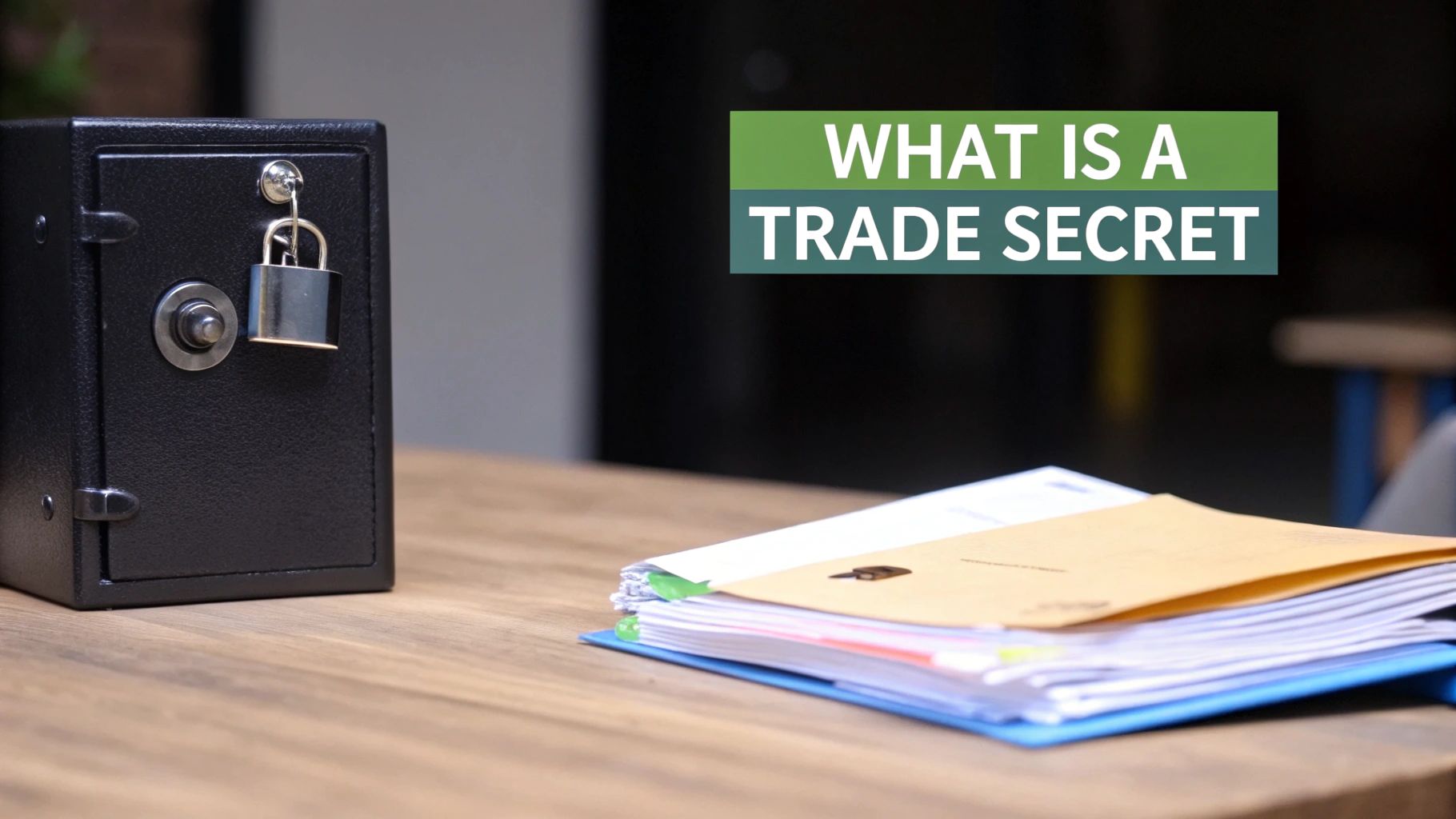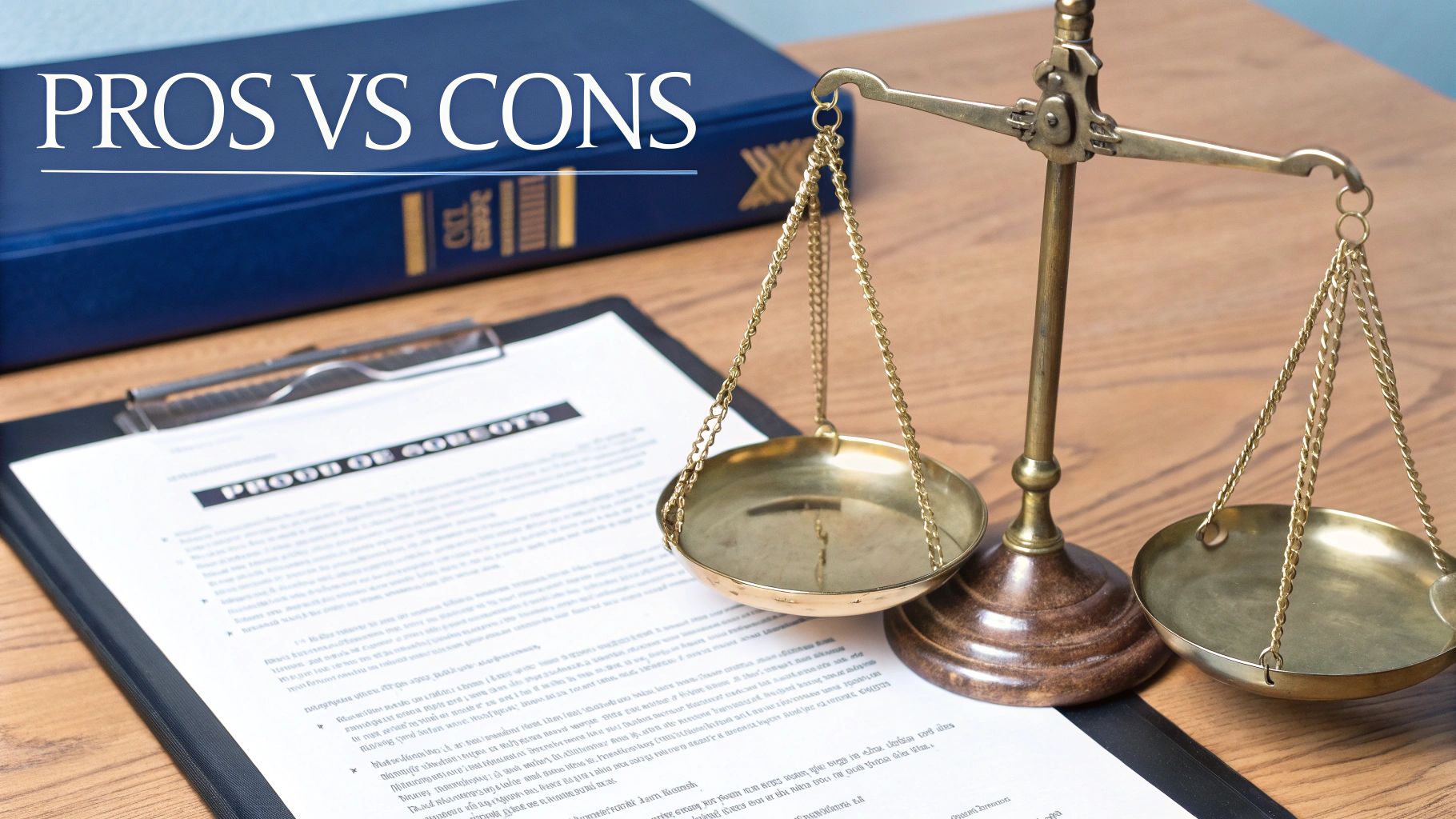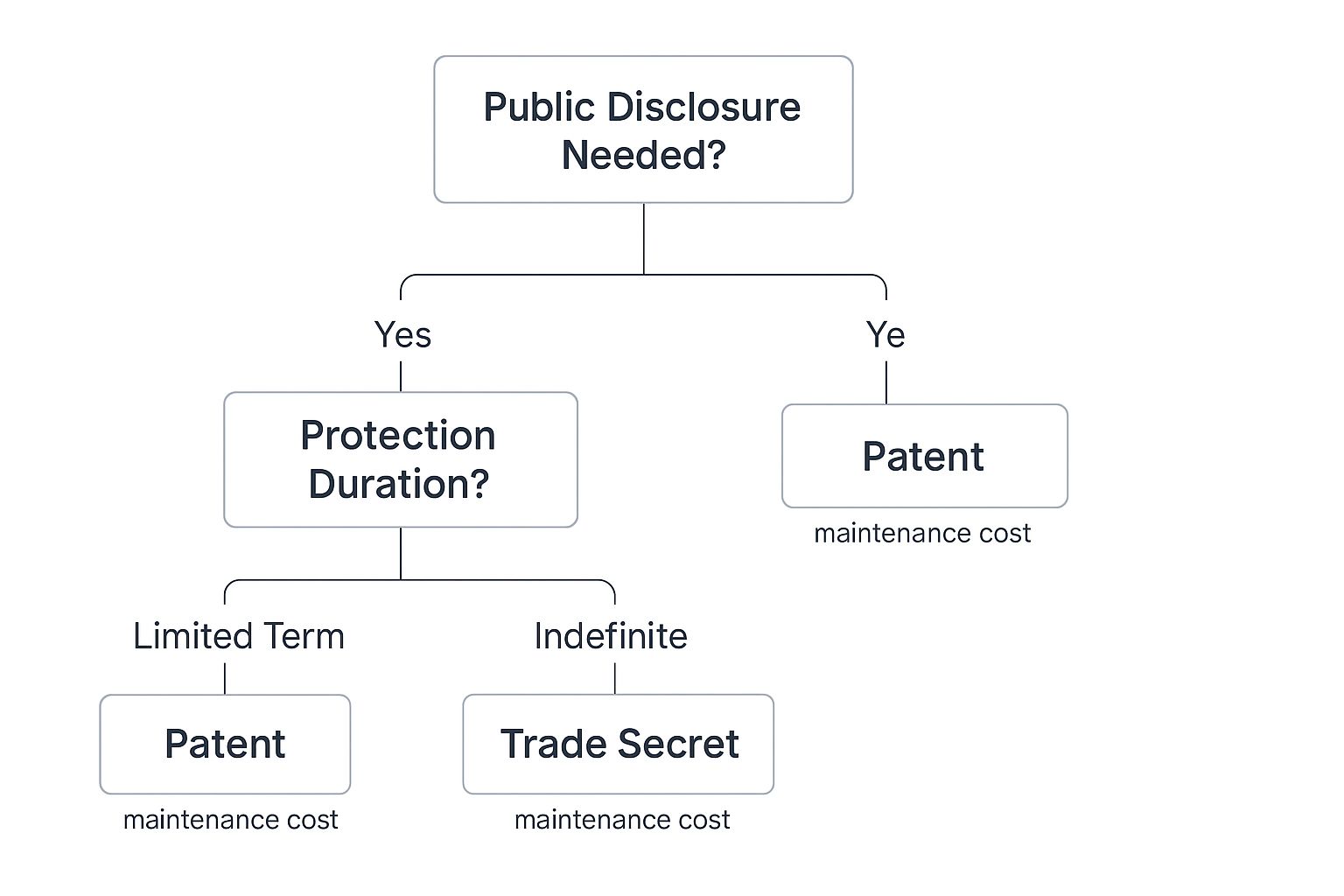Understanding What Really Separates These Protection Strategies
Deciding between a trade secret and a patent is not just a legal formality; it's a foundational business strategy that shapes your competitive advantage. The choice dictates how you monetize, defend, and grow your innovation. For instance, Coca-Cola’s legendary formula has remained a trade secret for more than a century, with its value tied directly to its confidentiality. On the other hand, pharmaceutical companies depend on patents to secure a temporary monopoly, which is essential for recouping the massive costs of R&D and regulatory approvals.
This fundamental split in strategy—trade secret vs patent—comes down to the nature of the innovation itself and the market it operates in.
The Core Philosophies: Secrecy vs. Disclosure
The main difference is their opposite approaches to public knowledge. A patent is essentially a bargain with the government: you publicly disclose every detail of your invention, and in return, you get an exclusive right to it for a limited time, typically 20 years. This disclosure is intended to enrich the public domain after the patent expires, sparking further innovation.
A trade secret, however, gets its value from being unknown. It offers protection for any confidential business information that gives you a competitive edge, as long as you take reasonable measures to keep it secret. This could be a recipe, a manufacturing process, a client list, or an algorithm. Unlike a patent, its protection is potentially indefinite, but it offers no defense if a competitor independently develops or reverse-engineers your innovation.
As the image shows, a trade secret can cover a wide range of information, from financial data to scientific formulas. This flexibility is a key reason why some businesses choose it over the more structured and rigid patent process.
Strategic Considerations for Innovators
The decision isn't always straightforward. An innovation that can be easily reverse-engineered from a final product is a poor candidate for a trade secret, making a patent the better choice. However, a complex internal process that cannot be figured out from the outside, like Google’s search algorithm, is a perfect fit for trade secret protection.
To help clarify the strategic trade-offs, the following table breaks down the core characteristics of each protection method.
Trade Secrets vs Patents: Core Characteristics Comparison
Side-by-side comparison of fundamental differences in protection scope, requirements, and legal basis
| Characteristic | Trade Secrets | Patents |
|---|---|---|
| Protection Basis | Maintained secrecy and providing a competitive advantage. | Government grant issued after a detailed examination process. |
| Public Disclosure | No, disclosure immediately destroys the protection. | Yes, full and detailed public disclosure is a core requirement. |
| Protection Duration | Potentially perpetual, lasting as long as the information is kept secret. | A limited term, typically 20 years from the filing date. |
| Key Requirement | Taking "reasonable efforts" to maintain secrecy. | Must be novel, non-obvious, and have a clear utility. |
| Independent Discovery | No protection against it. If someone figures it out on their own, they can use it. | Full protection. It prevents others from making, using, or selling the invention, even if independently discovered. |
Ultimately, choosing correctly requires a forward-thinking analysis of your business model, your market, and the nature of your intellectual property. Understanding the trade secret vs patent dynamic allows you to select the tool that best secures your unique creation and aligns with your long-term goals. For complex situations, getting can be a crucial step in aligning your IP strategy with your business vision.
Why Different Industries Make Radically Different Choices
The choice between a trade secret and a patent isn't made in a vacuum. It's a strategic decision shaped by industry pressures, how quickly products evolve, and the competitive environment. Think about why a software company might hide its algorithm as a trade secret, while a biotech firm rushes to patent a new gene sequence. The answer is found in how each industry builds and protects its value.
The Biotech and Pharmaceutical Calculus
In the worlds of biotech and pharmaceuticals, the guiding principle is often "patent or perish." Creating a new drug or medical device demands a massive upfront investment—often billions of dollars over a decade or more—with no guarantee of success. Once that product hits the market, its chemical makeup or design can be analyzed and copied.
Without the 20-year exclusivity that a patent offers, competitors could reproduce a successful drug for a tiny fraction of the original R&D expense. This would make it impossible for the innovating company to recover its investment. Patents are critical for attracting investors and establishing the market control needed to make these high-risk ventures financially possible. A trade secret provides almost no defense here, as the core innovation is revealed as soon as the product is sold.
Software and Tech’s Shift Toward Secrecy
In contrast, the software industry increasingly relies on trade secrets. Software development moves incredibly fast, and product lifecycles can be just a few years long. The patent application process, which can take two to three years, is often too slow. By the time a patent is approved, the software it was meant to protect might already be outdated.
Additionally, a patent forces a company to disclose its software's fundamental logic, basically giving competitors a blueprint. A well-protected algorithm, like those powering search rankings or content suggestions, is nearly impossible to reverse-engineer. Keeping it a trade secret allows for constant, quick updates without any public filing, creating a more lasting and adaptable competitive edge in a fast-paced market.
The Manufacturing and Consumer Goods Playbook
Industries like manufacturing and consumer goods frequently use a hybrid strategy. Take the beverage industry, where a unique formula is the most valuable asset. A 2021 National Science Foundation survey highlighted this, finding that 57.7% of beverage and tobacco manufacturers considered trade secrets "very important," far outpacing patents. You can see more details about these industry preferences in the full NSF survey report on .
The chart below illustrates how different sectors prioritize patents versus trade secrets.

This data shows that for industries where the main value lies in a process or formula, like food production, secrecy is key. On the other hand, for products like machinery or drugs that can be physically copied, patents become more important. A manufacturer might patent a new machine (the "how") but guard its specific, high-efficiency operational settings as a trade secret (the "secret sauce"). This layered approach creates multiple hurdles for any competitor trying to catch up.
The Real Financial Picture Beyond Application Fees
The initial costs of intellectual property protection are often deceptively simple. A common error is viewing the trade secret vs. patent choice as a decision between something free (a trade secret) and something expensive (a patent). The reality is that the financial commitment for both paths goes far beyond upfront fees, including ongoing investments, opportunity costs, and long-term strategic value. A closer look at the finances reveals a much more complex picture.

While this visual shows the high-level distinctions, the true costs surface over time. Trade secrets may dodge application fees, but they require continuous investment in security. In contrast, a patent's steep upfront cost is merely the first step of its financial lifecycle.
The True Cost of Patenting
Securing a patent is a major capital expense that many entrepreneurs underestimate. Patent protection typically involves a formal application process that takes an average of 2 to 3 years to grant, with costs ranging from $30,000 to $50,000 per patent, per country. This sum covers attorney fees for drafting the application, responding to patent office actions, and paying issuance fees. This multi-year process ties up capital that could otherwise fund product development or marketing efforts. You can learn more about the fundamental differences in cost and duration by exploring .
The expenses don't end once the patent is granted. To maintain the patent's enforceability for its full term, owners must pay regular maintenance fees. For a U.S. utility patent, these fees are due at the 3.5, 7.5, and 11.5-year marks and can total over $7,500. If your innovation needs protection in multiple countries, these application and maintenance costs multiply, quickly turning a single invention into a six-figure global investment.
The Hidden Costs of Trade Secrecy
Although a trade secret has no government registration fees, protecting it is hardly free. The law requires you to take "reasonable measures" to maintain secrecy, which translates directly into real, ongoing operational costs. These investments are essential—if you can't prove you took steps to protect your information, you lose your legal right to take action if it's stolen.
These measures often include:
- Physical Security: Implementing access controls, using secure storage for physical documents, and installing surveillance systems.
- Digital Security: Investing in a solid cybersecurity framework, including data encryption, access logs, and intrusion detection systems to guard against data breaches.
- Legal Frameworks: Drafting and consistently enforcing non-disclosure agreements (NDAs), confidentiality clauses in employment contracts, and specific policies for third-party collaborators.
- Employee Training: Regularly training employees on security protocols and the importance of confidentiality, which consumes both time and resources.
For a small business, these combined security and administrative costs can easily add up to thousands of dollars each year. Unlike a patent's more predictable upfront costs, these are perpetual expenses that grow as the company and the value of its secrets expand. This long-term financial commitment is a vital factor when weighing the trade secret vs patent options, requiring a careful budget forecast that goes beyond initial outlays.
To help visualize these long-term financial commitments, the table below breaks down the potential costs for both IP protection strategies over time.
Cost Analysis: Trade Secrets vs Patents Over Time
Detailed breakdown of initial, ongoing, and hidden costs for both protection methods across different time horizons
| Cost Category | Trade Secrets | Patents (Single Country) | Patents (Multiple Countries) |
|---|---|---|---|
| Initial Outlay (Year 1) | $2,000 – $10,000+ (Legal setup, initial security) | $15,000 – $30,000 (Drafting, filing fees) | $40,000 – $100,000+ (Multiple filings, translations) |
| Ongoing Annual Costs | $1,000 – $15,000+ (Security, training, legal) | ~$500 – $1,000 (Minor legal upkeep) | ~$1,500 – $5,000+ (Multiple local agent fees) |
| Periodic Major Costs | Varies with security upgrades/legal reviews | ~$7,500+ (Maintenance fees over 20 years) | ~$20,000 – $50,000+ (Multiple maintenance fees) |
| Enforcement Costs | Moderate to High (Proving theft, damages) | Very High ($500k – $4M+ per case) | Extremely High (Multiple jurisdictions) |
| Total 10-Year Est. Cost | $12,000 – $160,000+ | $25,000 – $45,000+ | $70,000 – $180,000+ |
This table clearly shows that the "free" option of a trade secret carries significant and perpetual operational costs. Conversely, the high initial cost of a patent can be more predictable over its lifespan, though international protection dramatically increases this figure. Your choice depends not just on the upfront budget but on your capacity for sustained financial investment in either security infrastructure or government fees.
What Protection Actually Means When Competitors Come Knocking
Theoretical protection is one thing; standing up to a competitor in court is another. The real test of your trade secret vs. patent strategy happens when someone infringes on your rights. The enforcement process reveals the stark, practical differences between these two forms of intellectual property. Understanding these differences is essential for building a defense that holds up under pressure, as the path to victory is rarely straightforward.
Proving Your Case: The Burden of Proof
When you take legal action, the specific facts you must prove to the court—your burden of proof—vary significantly between patents and trade secrets.
For a Patent: Enforcing a patent involves proving patent infringement. This is a relatively direct task. You must demonstrate that a competitor’s product or process contains every element described in at least one of your patent’s claims. It doesn't matter if they developed it independently or stumbled upon it by accident—if it matches your claim, it's infringement. The legal fight often focuses on interpreting the specific wording of the patent claims.
For a Trade Secret: To enforce a trade secret, you must prove trade secret misappropriation, which is a more complex, multi-part test. You are required to show that:
- The information qualifies as a legitimate trade secret (meaning it has economic value because it is not publicly known).
- You took reasonable steps to keep it secret, such as using non-disclosure agreements (NDAs) and implementing security measures.
- The competitor acquired, used, or disclosed the secret through improper means, like theft, bribery, or breaking a confidentiality agreement.
Even without evidence of physical theft, proving that a former employee used memorized information can be enough to establish misappropriation. This makes trade secret cases heavily dependent on circumstantial evidence and establishing a clear pattern of improper behavior.
The Realities of a Legal Battle
The enforcement process for patents is, by its nature, public. The patent document itself is a public record, detailing the invention for all to see. This public disclosure is a core part of the patent "bargain" and makes it very clear what is protected.
In contrast, litigating a trade secret case is a delicate dance. You must reveal the secret to the court to prove your case, usually under a protective order, which creates a risk of further exposure.
Even with a strong case, victory isn't guaranteed. In a notable case, a Virginia court overturned a massive $2 billion trade secret verdict. The court ruled that the damages were not properly proven to have resulted directly from the misappropriation. This highlights a critical point: you must be able to quantify the economic harm you suffered.
For patents, damages are often calculated based on lost profits or a reasonable royalty. For trade secrets, proving the value of what was stolen can be much more difficult. The rise in federal trade secret lawsuits since the Defend Trade Secrets Act (DTSA) was passed in 2016 shows the growing importance—and complexity—of these enforcement challenges.
How Smart Companies Layer Both Strategies for Maximum Impact
The discussion around trade secrets vs. patents often presents the decision as an either/or choice. In reality, the most resilient intellectual property strategies don't just pick one. Instead, they build a multi-layered defense by combining patents and trade secrets, creating a protective fortress that is much harder for competitors to breach than a single wall. This hybrid approach allows a company to strategically disclose certain parts of an innovation while keeping other critical components confidential.
This layered method is becoming a common practice. Companies worldwide, especially in innovation-heavy sectors, are increasingly using patents and trade secrets as complementary tools rather than substitutes. A detailed European Union study revealed that firms across most industries blend both methods based on the specific nature of their inventions and market goals. You can explore the full analysis of how European companies combine IP protection on euipo.europa.eu. This trend shows that the best approach isn't about choosing one over the other, but knowing when and how to deploy each.
Crafting a Hybrid Protection Plan
Putting a hybrid strategy into action demands careful planning. A popular tactic is to patent the parts of a product that are publicly visible or can be easily reverse-engineered, while protecting the underlying processes, formulas, or software algorithms as trade secrets.
Imagine a company that develops a new medical diagnostic device. The device itself—its physical structure and unique sensor technology—could be patented. This stops competitors from selling a similar-looking product. However, the proprietary AI algorithm that processes the sensor data to deliver a diagnosis would be maintained as a closely guarded trade secret. This way, even if a rival manages to design around the patent, they can't replicate the core function that makes the device so valuable.
The chart below highlights how frequently companies in various industries combine these strategies.
This data demonstrates that a substantial percentage of businesses, particularly in manufacturing and services, use both types of protection at the same time. The key takeaway is that patents guard the "what" (the invention), while trade secrets can protect the "how" (the process or secret ingredient), forging a more durable competitive edge.
Timing and Coordination Are Critical
Executing this strategy successfully hinges on precise timing. When you file a patent application, you start a clock that eventually leads to public disclosure. You must be certain that the application doesn't accidentally expose information you intend to keep as a trade secret. This is especially important for technology companies. For a deeper look at this, see our guide on intellectual property for software, which delves into these complexities.
For instance, when patenting an AI-related invention, the application needs to provide enough detail for it to be valid but not so much that it gives away the "secret sauce" of the training data or model architecture. A company might patent a method for pre-processing data for a machine learning model without revealing the unique, massive dataset used to train it, which remains a trade secret. This careful coordination plays to the strengths of each IP right, turning the trade secret vs. patent question from a dilemma into a powerful strategic toolkit.
Your Strategic Decision Framework That Actually Works

Choosing between a trade secret vs. patent isn't a random guess. It's a strategic decision that needs to balance the nature of your invention with your business goals. A useful framework goes beyond simple pro/con lists, forcing you to think about the real-world trade-offs that can affect your success down the road. By examining your innovation's specific traits alongside your company's bigger picture, you can land on a choice that genuinely protects your edge in the market.
This process means asking a few pointed questions that get to the core of the issue. It's the same method experienced IP strategists use to help entrepreneurs find the most logical and solid path to protection.
Key Questions for Your Innovation
First, take a hard look at the innovation itself. The answers here often point clearly toward one option or the other.
- Can it be reverse-engineered? If a competitor can buy your product and figure out how it works just by taking it apart, a trade secret is useless. This is a strong argument for getting a patent. On the other hand, a complex manufacturing process that happens behind closed doors is a perfect candidate for a trade secret.
- What is its commercial lifecycle? For an invention with a short shelf life, like a software feature that will be outdated in 18 months, the long and expensive patent process might not be practical. A trade secret offers immediate protection for its entire useful life. In contrast, a foundational technology expected to be valuable for decades deserves the 20-year exclusivity a patent provides.
Aligning Protection with Business Strategy
Next, think about how each form of protection fits into your wider business plans. Your IP decision should be a support, not a roadblock, to your company's growth.
- Do you need to attract investors? Venture capitalists and other investors often view patents as concrete, defensible assets. Having a granted patent can make your company a much more appealing investment. While valuable, trade secrets are often harder to explain and put a number on during the due diligence process.
- What is your exit strategy? If your goal is to sell the company, a solid patent portfolio can seriously boost its valuation. Patents are assets that can be sold or licensed. If you intend to keep the company private forever, the perpetual protection of a well-guarded trade secret might be more attractive.
The image below shows an overview of the different kinds of intellectual property, each with a different role in business.

This graphic makes it clear that patents and trade secrets are just two instruments in a larger IP toolkit. Making the right call means understanding how your specific business situation—from funding needs to market position—determines which instrument is the most effective. For entrepreneurs working through these choices, learning about the available legal help for small business can bring clarity and confidence, helping you build a smart IP foundation that supports your long-term goals.
From Decision to Protection: Your Implementation Roadmap
Choosing between a patent and a trade secret is just the first step. The real work begins when you put that decision into practice. An idea on paper has no value until you build a solid framework to protect it. This roadmap covers the practical, on-the-ground steps for establishing real protection, whether you've chosen secrecy or public disclosure.
This decision tree shows the basic questions that steer your choice.

The graphic highlights how factors like the need for public disclosure and how long you want protection to last are key in pushing an idea toward either a patent or a trade secret.
Implementing a Trade Secret Program
If you've decided on secrecy, your goal is to build a fortress of confidentiality around your information. This isn't a one-and-done task; it's a continuous operational commitment.
- Develop Comprehensive Policies: Your first move is to draft clear, enforceable Non-Disclosure Agreements (NDAs) and confidentiality policies. These documents should be required for all employees, contractors, and business partners, and they must spell out exactly what information is considered confidential.
- Implement Layered Security: Protection must be both digital and physical. This means using cybersecurity tools like data encryption and access controls while also securing physical spaces where sensitive work happens. These aren't just suggestions; they are the "reasonable measures" you'll need to prove in court if your secret is ever stolen.
- Establish Monitoring Systems: You must have a documented system for tracking who accesses sensitive information and when. Regular employee training is also critical to reinforce the importance of confidentiality and make sure everyone understands their legal obligations.
Navigating the Patent Process
Choosing the patent route launches you into a formal, structured, and often long legal process. Your success will depend on careful work and a strong partnership with legal experts.
- Work Effectively with a Patent Attorney: A patent attorney does more than file paperwork. They help you write patent claims that are broad enough for meaningful protection but specific enough to get approved. Expect a collaborative back-and-forth process that can take several months.
- Understand the Application Realities: Filing the application is only the start. The process with the involves responding to "office actions," where an examiner might challenge your invention's novelty. This correspondence can easily extend the process to 2-3 years before a decision is made.
- Manage Your Patent Portfolio: A granted patent is an asset that requires active management. This includes paying maintenance fees on time to keep the patent in force and watching the market for any potential infringement by competitors.
Whether you're building a wall of secrecy or navigating a government agency, effective implementation is what gives your innovation real protection. If you are an entrepreneur or creator looking to build a strong intellectual property foundation, the team at Cordero Law can offer the strategic guidance needed to turn your choice into a defensible asset.
